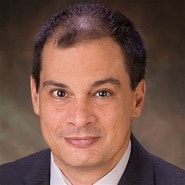
Stuart James, VP, Chief Operations Officer & Deputy CIO, CHRISTUS Health
To healthcare leaders, hearing the word “choppy” to describe communication among various care locations is like nails on a chalkboard. But when each specialty has “a different scheduling experience, a different set of instructions, and a different set of appointment reminders,” the description seems rather appropriate — or at the very least, honest.
“The data provided in most organizations is fragmented,” said Stuart James, VP, Chief Operations Officer & Deputy CIO, CHRISTUS Health, during a recent discussion. “It exists in many different places, and often we don’t have a well-defined and well-managed source of truth.” And without that in place, noted fellow panelist Chris Paravate (CIO, Northeast Georgia Health System), “getting patients to the right place with the right information in front of the right provider,” becomes extremely difficult.
“It’s been a journey for us,” he said. Particularly as healthcare organizations continue to grow at staggering rates, whether through acquisitions or partnerships, the ability to “pull the data and create a lens to understand the problems” is becoming increasingly important — and difficult. “We need to ensure we have access at the appropriate places to the right level of providers and the right clinical care.”
During the webinar, Paravate and James described the challenges leaders face and outlined their approaches, along with Craig Richardville (CIO, Intermountain Health) and Scott Andrews (Chief Delivery & Operations Officer, Kyruus Health).

Chris Paravate, CIO, Northeast Georgia Health System
At its core, the problem stems from a lack of interoperability, said Paravate, whose own organization has seen significant expansion in recent years. While the individual entities that make up the 5-hospital, 900-bed system do a sufficient job with scheduling and creating access, the question becomes how to successfully streamline those tasks, “and beyond that, choreograph care across the continuum,” he noted. “I’m looking at trying to create a three-dimensional look to really start to drive strategic decision making.”
Finding the source of truth
James’ experience has been similar, noting that data exists “in many different places and many different formats” at CHRISTUS, a Dallas, Texas-based IDN with more than 60 hospitals and 600 care delivery centers across several states (and even internationally). Adding to the problem is the fact that “often we don’t have a well-defined and well-managed source of truth,” he said.
When that happens, organizations aren’t able to provide the brand of personalized care and services to which consumers have become accustomed. “There’s a certain expectation of what the experience looks like, and it’s being driven by the other things people do, whether it’s shopping online or booking an airline ticket,” said James. “They want this done now.”
And while healthcare organizations certainly aren’t in a position to replicate the Amazon experience, they can take steps in that direction by offering viable options — even if it’s not precisely what the customer wanted. “If we understand that, we can then say, ‘we know you wanted to see Dr. X in Location Y, but we found a similarly qualified surgeon who can see you in location K.’ We have to rethink the experience within the paradigm of everything else that people do in their daily lives, and meet them where they are,” he noted.
Stewardship & culture
Creating an Amazon-like experience that matches patients with the best possible care based on their needs and location will require a strong foundation along with solid analytics capabilities, according to the panelists. Not only does it mean knowing which locations provide specialty care; it’s also being able identify markets that lack certain types of care — and therefore present either a challenge or an opportunity.

Scott Andrews, General Manager, Health Systems, Kyruus
“If you’re looking for care and we can say, ‘we found a location that’s closer to you,’ that could impact the consumer’s decision and overall satisfaction,” said James. That’s where having a solid data stewardship strategy and a strong data culture come into play. “Your provider data, in many ways, is your inventory,” he noted.
By being able to understand that inventory and decipher where gaps exist in the market, organizations can more effectively fill them — as long as they have the right tools and processes in place, according to Andrews. “Part of what Kyruus can do for our customers is to provide insights into where individuals are searching for care, and what they’re searching for,” he said. As leaders enter the decision-making process, “having insight into the type of data patients are searching for, the words they’re using, and where they’re searching from, can be really powerful.”
Calm from chaos
Andrews believes that Kyruus’ care access platform can “create calm out of the chaos with the solutions we bring to bear,” from implementation to support.

Craig Richardville, Chief Digital & Information Officer, Intermountain Healthcare
The support piece, according to James, can’t be overstated, particularly when organizations experience rapid growth, which can ramp up the complexity. “It’s more data sources and more everything that we have to harmonize,” he said. “It brings in additional challenges, but it also highlights the importance of having robust, accurate, actionable provider data, because now your inventory has changed, and your service locations have changed.” The level of service, however, can’t change.
And it starts and ends with data.
“We don’t manufacture parts of equipment,” said Richardville. “We produce data. That’s what drives our decisions.” In order to do that effectively, “it needs to be simple. It needs to be personalized and tailored toward the patient and their needs,” he added. “It has to be intuitive so that users can take action on it. That’s the most important part.”
To view the archive of this webinar — Unleash the Power of Provider Data: Gain Operational Efficiencies and Improve Care Access with a Single Source of Truth (Sponsored by Kyruus Health) — please click here.


Share Your Thoughts
You must be logged in to post a comment.